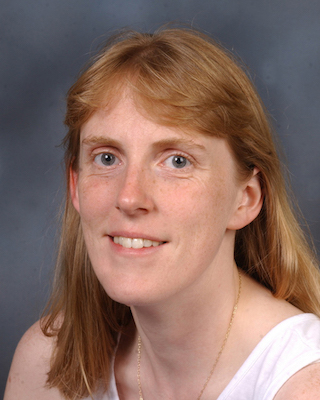Teaching Excellence at Yale
Taking time to replicate the processes of scientific discourse in small groups can transform learning potential in large classes.
Helen Caines, Associate Professor of Physics (pictured below), knows that solving scientific problems involves exploring multiple possible answers, different routes to a solution, and robust discussions among researchers. Having students participate in these types of interactions is essential for their learning, but large science classes do not easily foster such work. Professor Caines overcomes obstacles posed by using small group problem solving in large classes through meticulous organization, attention to student interactions, and the willingness to put herself in the center of the room.

“Students need to know what your expectations are from the beginning,” she explains. Spending dedicated time on student introductions, highlighting regularly that it is OK not to know how to solve problems immediately – that the discovery process is equally as important as the solution – and emphasizing reflection that leads to deeper understanding are all things that students need to know if using small groups is going be a successful teaching and learning technique.
Caines also notes that one must avoid “plug and chug” questions when working with small groups in the classroom. ”They have to be questions that have more than one way to solve them or involve multiple steps. And, the questions can be more complex than you would give for homework,” because students have their groups, as well as the professor and the TFs to draw on for real-time help.
Small group activities take much longer than one would first guess, says Caines. But having everyone involved in digesting the assignment and discussing possible solutions gives rise to students who are more confident about correct responses, and who more often than not, feel as though they have directly participated in solving scientific problems.
Research exploring the impact of using small groups in large classes:
Andis Klergeris, a professor of Biology, and Heather Hurren, at the Centre for Teaching and Learning at the University of British Columbia, offer evidence of the robust positive effect that problem-based learning has on their students’ learning in a large classroom setting. Read this article online via Advances in Physiology Education.
Jenny Knight and Bill Wood, professors of Molecular, Cellular, and Developmental Biology at the University of Colorado Boulder, show that well-organized group activities in class confers an advantage to less prepared student populations and can result in increased learning gains. Read this article online via Cell Biology Education.
Share with us or a colleague:
View or download a PDF version below. Send us your feedback and suggestions. To opt-out/opt-in to this newsletter, please visit Yale’s messaging service website and follow the on-screen instructions (see instructions in the sidebar above).
